Importance of Time-Driven Activity-Based Costing in McPherson’sLtd
VerifiedAdded on 2024/04/17
|13
|2654
|179
AI Summary
This assignment explores the suitability of Time-Driven Activity-Based Costing (TDABC) for McPherson’sLtd, comparing it with traditional costing systems. It delves into the features of TDABC, its benefits, and how it can enhance resource utilization and cost efficiency for the organization.
Contribute Materials
Your contribution can guide someone’s learning journey. Share your
documents today.
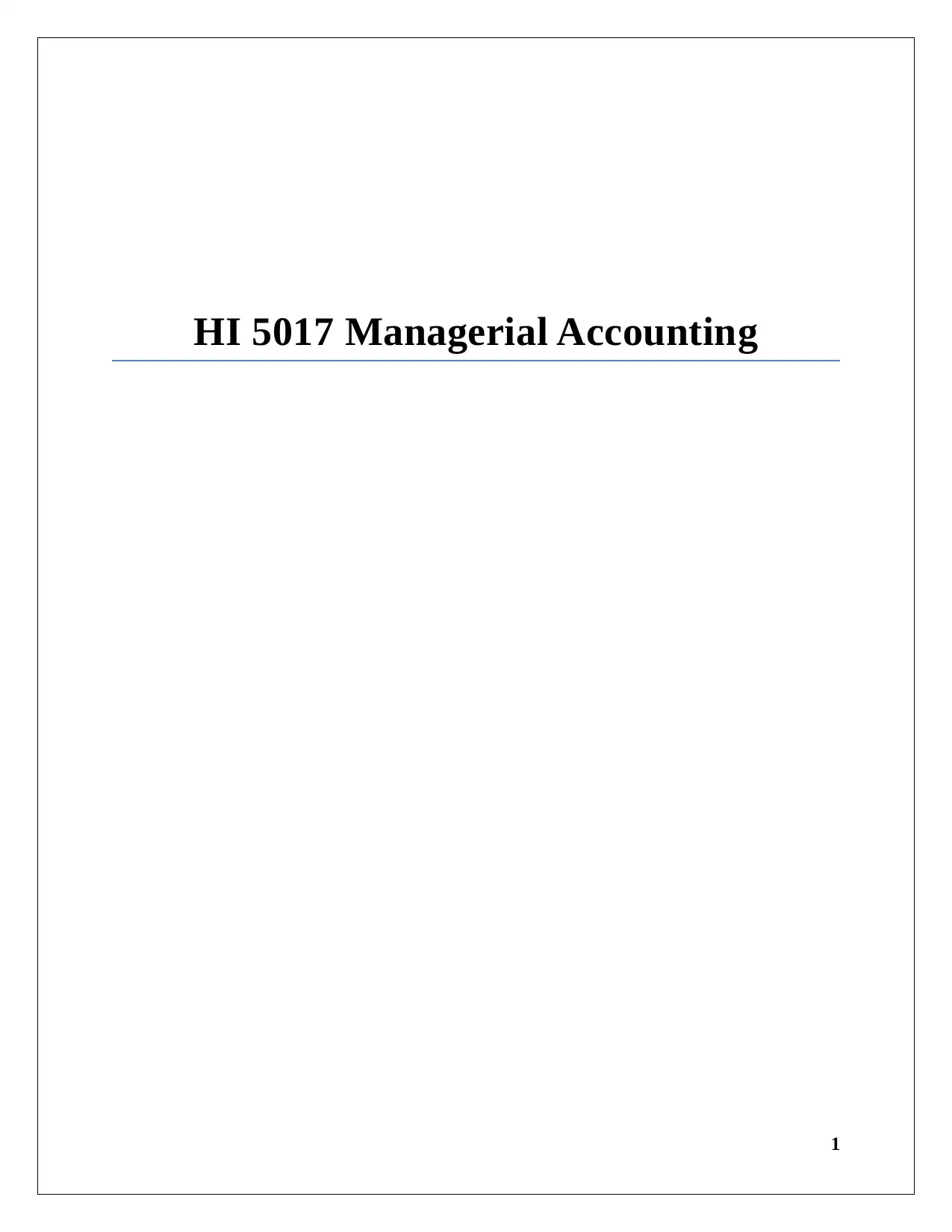
HI 5017 Managerial Accounting
1
1
Secure Best Marks with AI Grader
Need help grading? Try our AI Grader for instant feedback on your assignments.
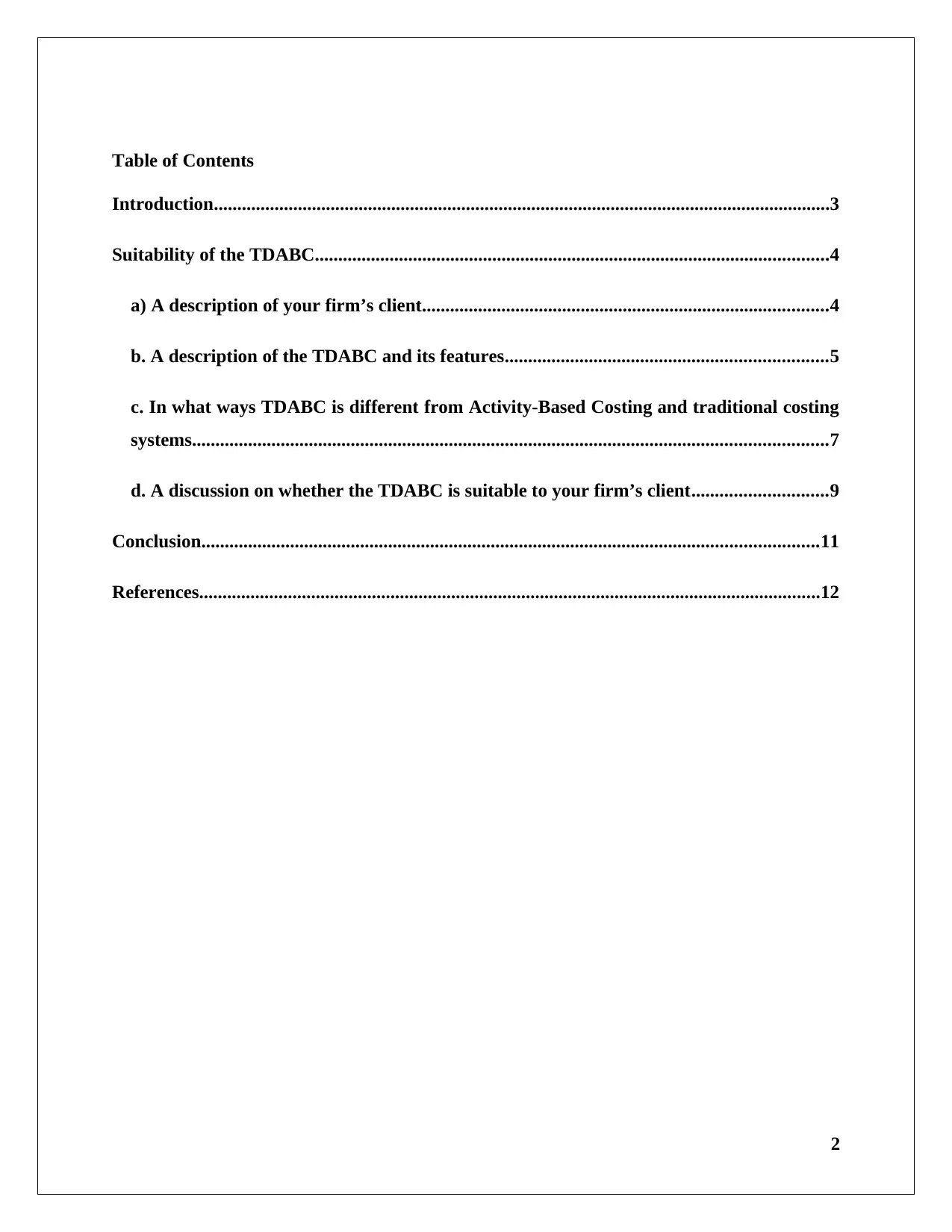
Table of Contents
Introduction....................................................................................................................................3
Suitability of the TDABC..............................................................................................................4
a) A description of your firm’s client.......................................................................................4
b. A description of the TDABC and its features.....................................................................5
c. In what ways TDABC is different from Activity-Based Costing and traditional costing
systems........................................................................................................................................7
d. A discussion on whether the TDABC is suitable to your firm’s client.............................9
Conclusion....................................................................................................................................11
References.....................................................................................................................................12
2
Introduction....................................................................................................................................3
Suitability of the TDABC..............................................................................................................4
a) A description of your firm’s client.......................................................................................4
b. A description of the TDABC and its features.....................................................................5
c. In what ways TDABC is different from Activity-Based Costing and traditional costing
systems........................................................................................................................................7
d. A discussion on whether the TDABC is suitable to your firm’s client.............................9
Conclusion....................................................................................................................................11
References.....................................................................................................................................12
2
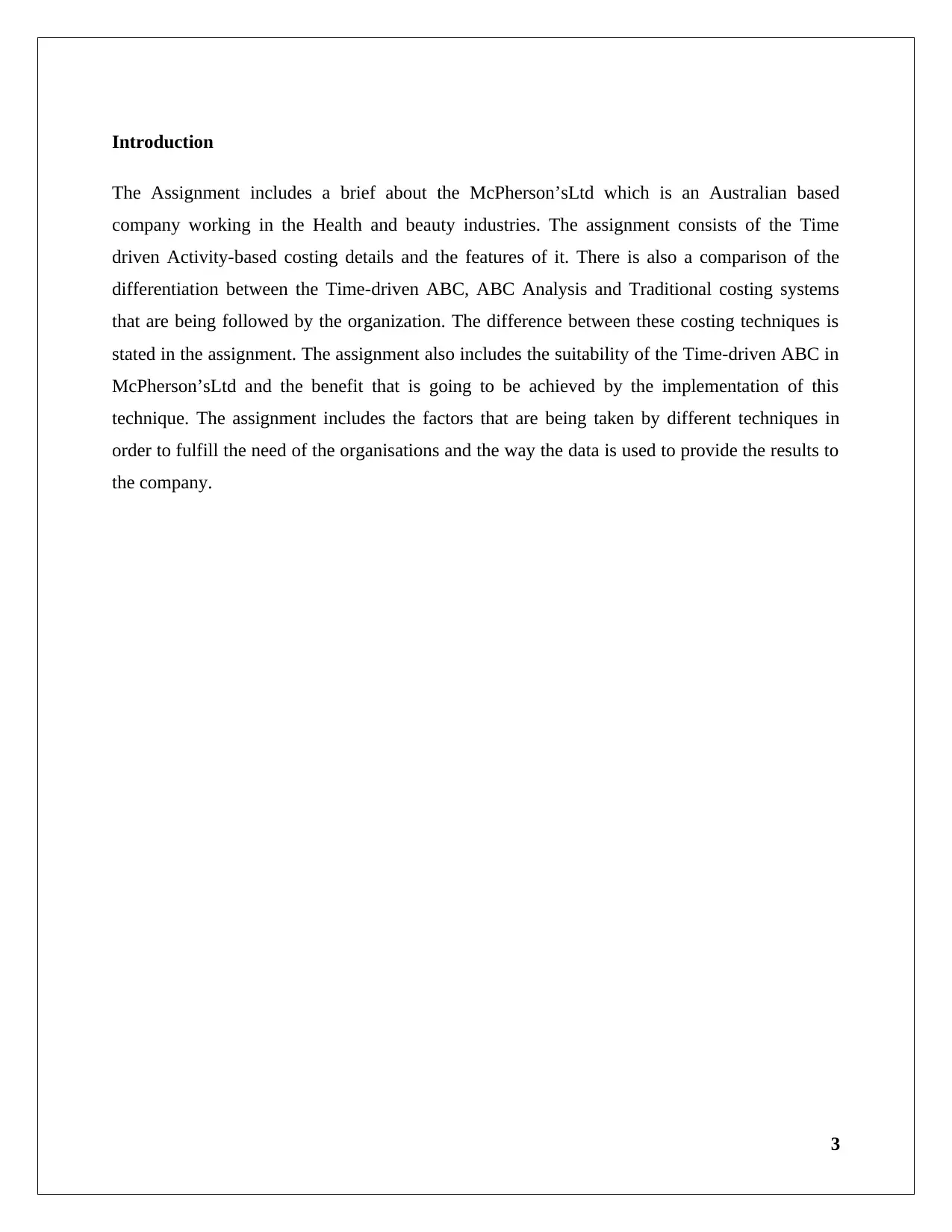
Introduction
The Assignment includes a brief about the McPherson’sLtd which is an Australian based
company working in the Health and beauty industries. The assignment consists of the Time
driven Activity-based costing details and the features of it. There is also a comparison of the
differentiation between the Time-driven ABC, ABC Analysis and Traditional costing systems
that are being followed by the organization. The difference between these costing techniques is
stated in the assignment. The assignment also includes the suitability of the Time-driven ABC in
McPherson’sLtd and the benefit that is going to be achieved by the implementation of this
technique. The assignment includes the factors that are being taken by different techniques in
order to fulfill the need of the organisations and the way the data is used to provide the results to
the company.
3
The Assignment includes a brief about the McPherson’sLtd which is an Australian based
company working in the Health and beauty industries. The assignment consists of the Time
driven Activity-based costing details and the features of it. There is also a comparison of the
differentiation between the Time-driven ABC, ABC Analysis and Traditional costing systems
that are being followed by the organization. The difference between these costing techniques is
stated in the assignment. The assignment also includes the suitability of the Time-driven ABC in
McPherson’sLtd and the benefit that is going to be achieved by the implementation of this
technique. The assignment includes the factors that are being taken by different techniques in
order to fulfill the need of the organisations and the way the data is used to provide the results to
the company.
3
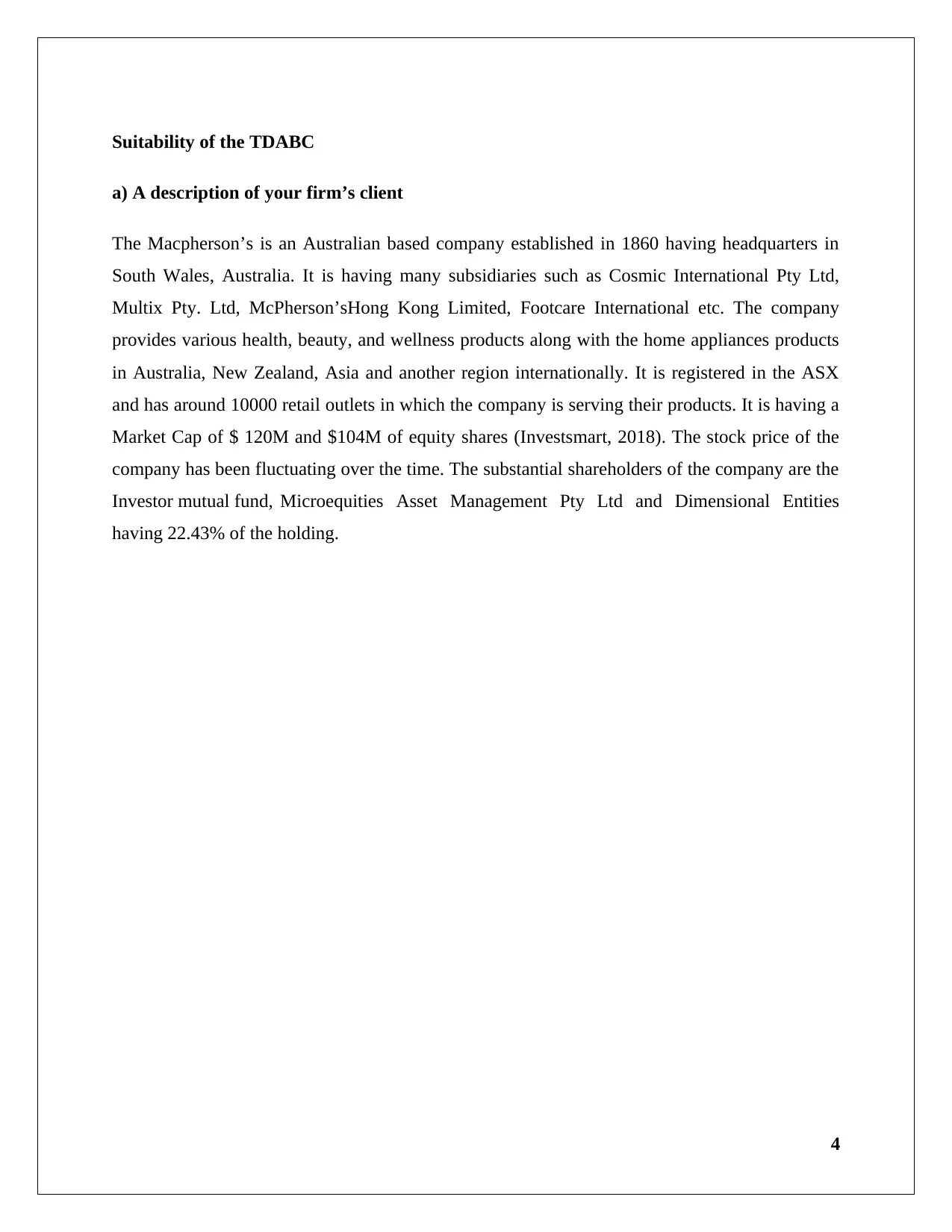
Suitability of the TDABC
a) A description of your firm’s client
The Macpherson’s is an Australian based company established in 1860 having headquarters in
South Wales, Australia. It is having many subsidiaries such as Cosmic International Pty Ltd,
Multix Pty. Ltd, McPherson’sHong Kong Limited, Footcare International etc. The company
provides various health, beauty, and wellness products along with the home appliances products
in Australia, New Zealand, Asia and another region internationally. It is registered in the ASX
and has around 10000 retail outlets in which the company is serving their products. It is having a
Market Cap of $ 120M and $104M of equity shares (Investsmart, 2018). The stock price of the
company has been fluctuating over the time. The substantial shareholders of the company are the
Investor mutual fund, Microequities Asset Management Pty Ltd and Dimensional Entities
having 22.43% of the holding.
4
a) A description of your firm’s client
The Macpherson’s is an Australian based company established in 1860 having headquarters in
South Wales, Australia. It is having many subsidiaries such as Cosmic International Pty Ltd,
Multix Pty. Ltd, McPherson’sHong Kong Limited, Footcare International etc. The company
provides various health, beauty, and wellness products along with the home appliances products
in Australia, New Zealand, Asia and another region internationally. It is registered in the ASX
and has around 10000 retail outlets in which the company is serving their products. It is having a
Market Cap of $ 120M and $104M of equity shares (Investsmart, 2018). The stock price of the
company has been fluctuating over the time. The substantial shareholders of the company are the
Investor mutual fund, Microequities Asset Management Pty Ltd and Dimensional Entities
having 22.43% of the holding.
4
Paraphrase This Document
Need a fresh take? Get an instant paraphrase of this document with our AI Paraphraser

b. A description of the TDABC and its features
The Time driven Activity-based costing is the new technique evolved after the drawbacks in the
Activity-based costing. The time driven Activity costing allocates the cost involved in the
process and work are done on the basis of the time required for the performance of that particular
work or the process. The ABC and traditional technique was not at all effective and efficient and
also required a lot of time for carrying out the different result and analysis. It also made the data
out-dated because of the delay in finding out the results and reporting them. The TDABC was
more effective and less complicated which later increased the adaptability by thevarious
organization for different purposes. The Time-driven ABC was developed by the Kaplan and
Anderson in order to overcome the issues faced by the ABC Analysis. The Time-Driven ABC
Involves the capacity and the cost of the resources and the time involved in conducting it.
The Time-Driven ABC analysis is having following features:-
a. Implementation -The Time-Driven ABC analysis can be easily implemented in the
organisation and estimated. It does not take in accounts different factors and estimates for
carrying out the result and analysis. The Time-Driven ABC is more effective and efficient in
implementation in an organisation as sit takes only two factors for the calculation and analysis
which are the Time constraint and cost involved. It can be easily understood as compared to the
traditional and ABC analysis which required a lot of efforts to understand.
b. Modification in the process -Effective and efficient in updating the changes that are
undergone in processes or the cost that is involved. The Time-Driven ABC analysis eases the
changes that are required to be done in any process or the work.The factors that are been taken
for the Time-Driven ABC analysis are easily adaptable if any changes are done which helps in
effective and efficient management, unlike the tradition ABC analysis.
c. Linking with ERP System -The Time-Driven ABC can be linked to the ERP and CRM
Systems making the transaction to be easily handled irrespective of the size of the transaction
that is being carried out by the organisation. The Linking with ERP also facilitates in saving the
data and respond to the changes that are done more effectively. It does not require a long analysis
and procedure ERP and CRM make it easy and results are calculated accurately and timely.
5
The Time driven Activity-based costing is the new technique evolved after the drawbacks in the
Activity-based costing. The time driven Activity costing allocates the cost involved in the
process and work are done on the basis of the time required for the performance of that particular
work or the process. The ABC and traditional technique was not at all effective and efficient and
also required a lot of time for carrying out the different result and analysis. It also made the data
out-dated because of the delay in finding out the results and reporting them. The TDABC was
more effective and less complicated which later increased the adaptability by thevarious
organization for different purposes. The Time-driven ABC was developed by the Kaplan and
Anderson in order to overcome the issues faced by the ABC Analysis. The Time-Driven ABC
Involves the capacity and the cost of the resources and the time involved in conducting it.
The Time-Driven ABC analysis is having following features:-
a. Implementation -The Time-Driven ABC analysis can be easily implemented in the
organisation and estimated. It does not take in accounts different factors and estimates for
carrying out the result and analysis. The Time-Driven ABC is more effective and efficient in
implementation in an organisation as sit takes only two factors for the calculation and analysis
which are the Time constraint and cost involved. It can be easily understood as compared to the
traditional and ABC analysis which required a lot of efforts to understand.
b. Modification in the process -Effective and efficient in updating the changes that are
undergone in processes or the cost that is involved. The Time-Driven ABC analysis eases the
changes that are required to be done in any process or the work.The factors that are been taken
for the Time-Driven ABC analysis are easily adaptable if any changes are done which helps in
effective and efficient management, unlike the tradition ABC analysis.
c. Linking with ERP System -The Time-Driven ABC can be linked to the ERP and CRM
Systems making the transaction to be easily handled irrespective of the size of the transaction
that is being carried out by the organisation. The Linking with ERP also facilitates in saving the
data and respond to the changes that are done more effectively. It does not require a long analysis
and procedure ERP and CRM make it easy and results are calculated accurately and timely.
5
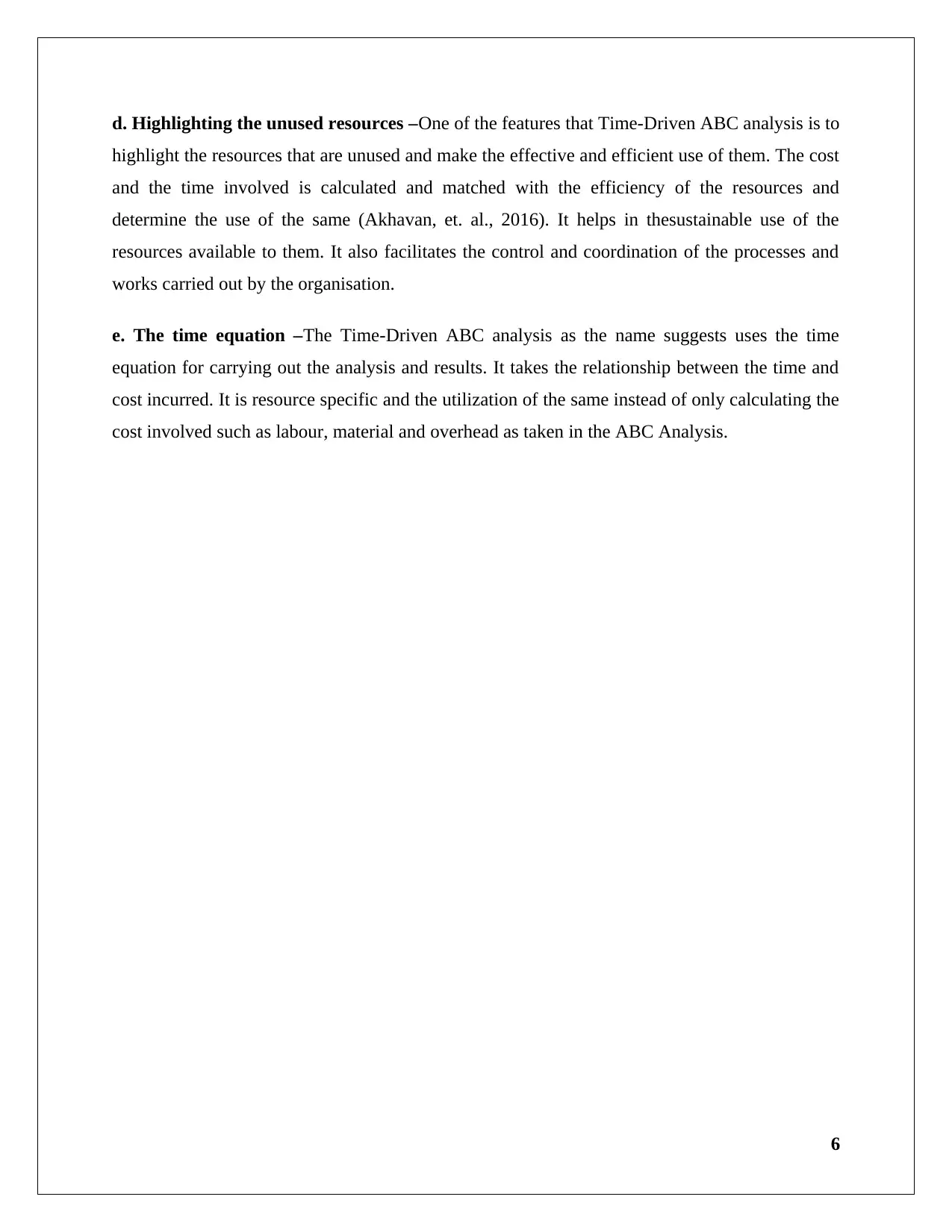
d. Highlighting the unused resources –One of the features that Time-Driven ABC analysis is to
highlight the resources that are unused and make the effective and efficient use of them. The cost
and the time involved is calculated and matched with the efficiency of the resources and
determine the use of the same (Akhavan, et. al., 2016). It helps in thesustainable use of the
resources available to them. It also facilitates the control and coordination of the processes and
works carried out by the organisation.
e. The time equation –The Time-Driven ABC analysis as the name suggests uses the time
equation for carrying out the analysis and results. It takes the relationship between the time and
cost incurred. It is resource specific and the utilization of the same instead of only calculating the
cost involved such as labour, material and overhead as taken in the ABC Analysis.
6
highlight the resources that are unused and make the effective and efficient use of them. The cost
and the time involved is calculated and matched with the efficiency of the resources and
determine the use of the same (Akhavan, et. al., 2016). It helps in thesustainable use of the
resources available to them. It also facilitates the control and coordination of the processes and
works carried out by the organisation.
e. The time equation –The Time-Driven ABC analysis as the name suggests uses the time
equation for carrying out the analysis and results. It takes the relationship between the time and
cost incurred. It is resource specific and the utilization of the same instead of only calculating the
cost involved such as labour, material and overhead as taken in the ABC Analysis.
6

c. In what ways TDABC is different from Activity-Based Costing and traditional costing
systems
The ABC method which was a predecessor of the TDABC faces much of condemnation rather
than appraisal because of the drawbacks that were there with it (Monroy, et. al., 2012). Though it
was better than the traditional costing systems still the flaws were much more than the value that
is provided to the organization because of which it was not accepted widely.TDABC was
introduced with the motive to overcome the flaws but according to Gervais, et. al., (2010) the
relation between the ABC method and TDABC was not there at all and they are a different
approach.
The TDABC is different as compare to the Activity Based costing and traditional costing in
the following way:-
a. The TDABC is easy to understand and the time required is less for development whereas in
case of the ABC and traditional approach lot of calculations are required in order to develop
them. TDABC is more time saving whereas they are the time-consuming approach. There are
only two standards which frame the overall development of TDABC in an organisation.
b. The TDABC is easy to modify because of the standards and easy to adapt to the changes
whereas in case of ABC and traditional approach it would be very difficult if any changes are
there in the processes and work performed by theorganisation.The traditional technique needs to
be developed again with the change in the methods and process.
c. TDABC is able to allocate all the cost that is being incurred with respect to the product
produced but in case of traditional and ABC Approach only the direct, indirect and the overhead
costs are being charged to the product which was not effective for finding out the performance
(Wilkinson, 2013). TDABC is valid for all types of organisation and in many industries because
of the standards and the allocation of the cost involved on the basis of the time involved instead
of the product manufactured.
d. According to Oracle, (2018) TDABC can be easily integrated with the available ERP Systems
and other software that help inaccurate results and correct recoding of the transaction that are
7
systems
The ABC method which was a predecessor of the TDABC faces much of condemnation rather
than appraisal because of the drawbacks that were there with it (Monroy, et. al., 2012). Though it
was better than the traditional costing systems still the flaws were much more than the value that
is provided to the organization because of which it was not accepted widely.TDABC was
introduced with the motive to overcome the flaws but according to Gervais, et. al., (2010) the
relation between the ABC method and TDABC was not there at all and they are a different
approach.
The TDABC is different as compare to the Activity Based costing and traditional costing in
the following way:-
a. The TDABC is easy to understand and the time required is less for development whereas in
case of the ABC and traditional approach lot of calculations are required in order to develop
them. TDABC is more time saving whereas they are the time-consuming approach. There are
only two standards which frame the overall development of TDABC in an organisation.
b. The TDABC is easy to modify because of the standards and easy to adapt to the changes
whereas in case of ABC and traditional approach it would be very difficult if any changes are
there in the processes and work performed by theorganisation.The traditional technique needs to
be developed again with the change in the methods and process.
c. TDABC is able to allocate all the cost that is being incurred with respect to the product
produced but in case of traditional and ABC Approach only the direct, indirect and the overhead
costs are being charged to the product which was not effective for finding out the performance
(Wilkinson, 2013). TDABC is valid for all types of organisation and in many industries because
of the standards and the allocation of the cost involved on the basis of the time involved instead
of the product manufactured.
d. According to Oracle, (2018) TDABC can be easily integrated with the available ERP Systems
and other software that help inaccurate results and correct recoding of the transaction that are
7
Secure Best Marks with AI Grader
Need help grading? Try our AI Grader for instant feedback on your assignments.
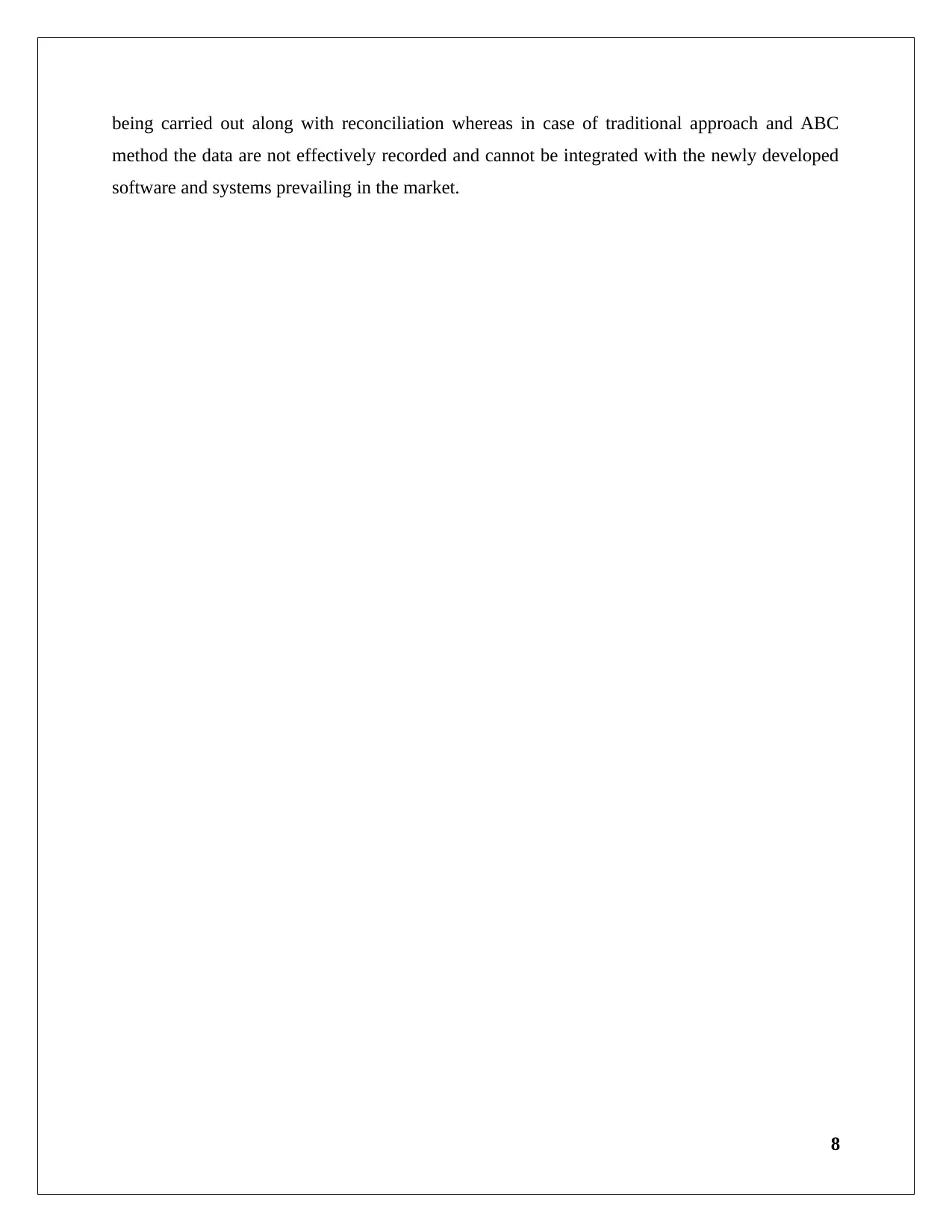
being carried out along with reconciliation whereas in case of traditional approach and ABC
method the data are not effectively recorded and cannot be integrated with the newly developed
software and systems prevailing in the market.
8
method the data are not effectively recorded and cannot be integrated with the newly developed
software and systems prevailing in the market.
8
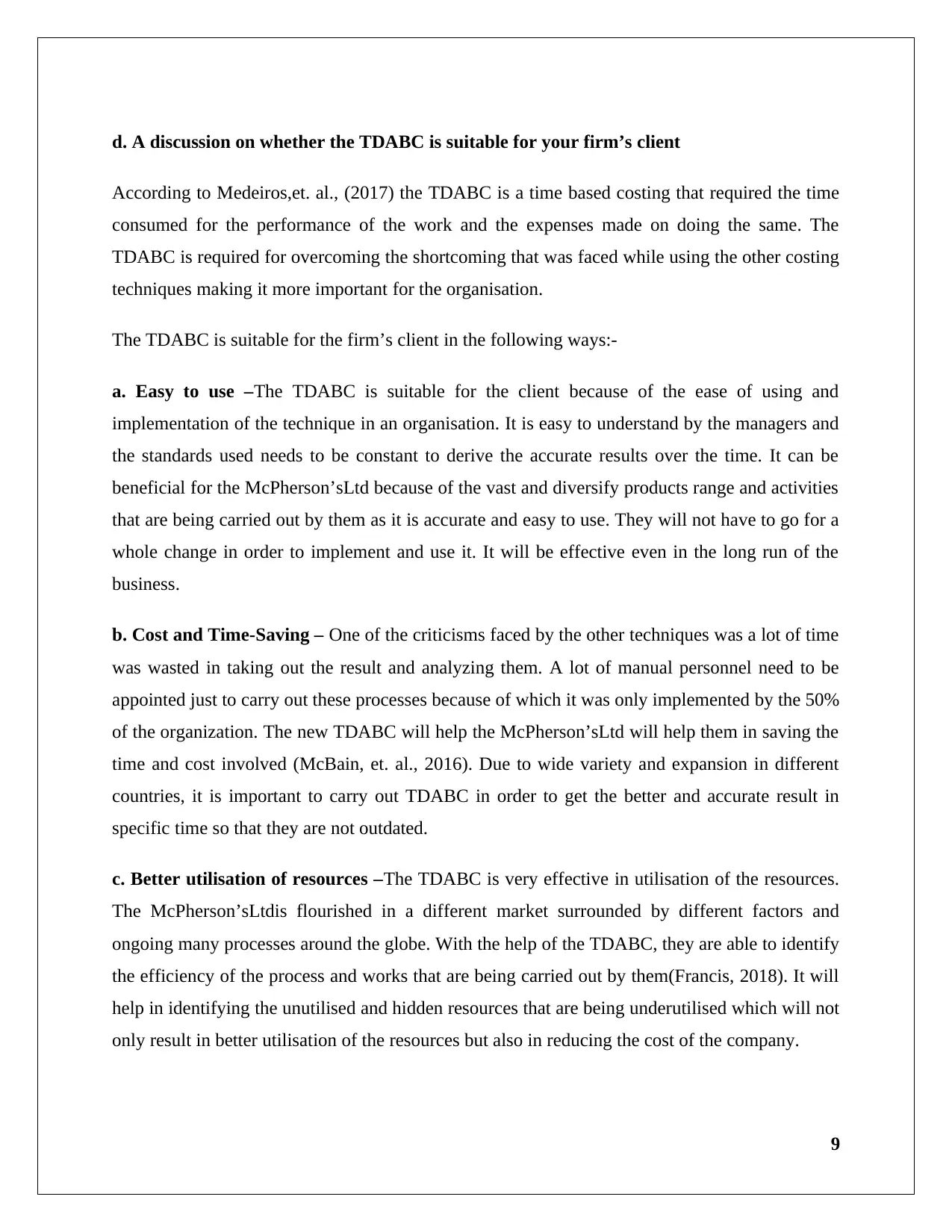
d. A discussion on whether the TDABC is suitable for your firm’s client
According to Medeiros,et. al., (2017) the TDABC is a time based costing that required the time
consumed for the performance of the work and the expenses made on doing the same. The
TDABC is required for overcoming the shortcoming that was faced while using the other costing
techniques making it more important for the organisation.
The TDABC is suitable for the firm’s client in the following ways:-
a. Easy to use –The TDABC is suitable for the client because of the ease of using and
implementation of the technique in an organisation. It is easy to understand by the managers and
the standards used needs to be constant to derive the accurate results over the time. It can be
beneficial for the McPherson’sLtd because of the vast and diversify products range and activities
that are being carried out by them as it is accurate and easy to use. They will not have to go for a
whole change in order to implement and use it. It will be effective even in the long run of the
business.
b. Cost and Time-Saving – One of the criticisms faced by the other techniques was a lot of time
was wasted in taking out the result and analyzing them. A lot of manual personnel need to be
appointed just to carry out these processes because of which it was only implemented by the 50%
of the organization. The new TDABC will help the McPherson’sLtd will help them in saving the
time and cost involved (McBain, et. al., 2016). Due to wide variety and expansion in different
countries, it is important to carry out TDABC in order to get the better and accurate result in
specific time so that they are not outdated.
c. Better utilisation of resources –The TDABC is very effective in utilisation of the resources.
The McPherson’sLtdis flourished in a different market surrounded by different factors and
ongoing many processes around the globe. With the help of the TDABC, they are able to identify
the efficiency of the process and works that are being carried out by them(Francis, 2018). It will
help in identifying the unutilised and hidden resources that are being underutilised which will not
only result in better utilisation of the resources but also in reducing the cost of the company.
9
According to Medeiros,et. al., (2017) the TDABC is a time based costing that required the time
consumed for the performance of the work and the expenses made on doing the same. The
TDABC is required for overcoming the shortcoming that was faced while using the other costing
techniques making it more important for the organisation.
The TDABC is suitable for the firm’s client in the following ways:-
a. Easy to use –The TDABC is suitable for the client because of the ease of using and
implementation of the technique in an organisation. It is easy to understand by the managers and
the standards used needs to be constant to derive the accurate results over the time. It can be
beneficial for the McPherson’sLtd because of the vast and diversify products range and activities
that are being carried out by them as it is accurate and easy to use. They will not have to go for a
whole change in order to implement and use it. It will be effective even in the long run of the
business.
b. Cost and Time-Saving – One of the criticisms faced by the other techniques was a lot of time
was wasted in taking out the result and analyzing them. A lot of manual personnel need to be
appointed just to carry out these processes because of which it was only implemented by the 50%
of the organization. The new TDABC will help the McPherson’sLtd will help them in saving the
time and cost involved (McBain, et. al., 2016). Due to wide variety and expansion in different
countries, it is important to carry out TDABC in order to get the better and accurate result in
specific time so that they are not outdated.
c. Better utilisation of resources –The TDABC is very effective in utilisation of the resources.
The McPherson’sLtdis flourished in a different market surrounded by different factors and
ongoing many processes around the globe. With the help of the TDABC, they are able to identify
the efficiency of the process and works that are being carried out by them(Francis, 2018). It will
help in identifying the unutilised and hidden resources that are being underutilised which will not
only result in better utilisation of the resources but also in reducing the cost of the company.
9

d. Control and coordination –Every organisation needs to better control and coordinate
especially when they are flourished in all over the world. TDABC can help with better control
and coordination of the McPherson’sLtd by making the process effective and efficient along with
the continuous improvement of the processes. It can be also achieved as TDABC can set the path
on basis of which the managers need to work providing them a clear pictureof the goals and
objective that the company is looking forward to achieving.
e. New technology and enhancements –The technologies and enhancements are becoming
advance with the time and it is necessary to adopt in the business in order to get an edge over the
others and be competitive. There is much software which has enhanced the workings of the
organisation such as SAP, ORACLE etc. (Adrian-Cosmin, 2015). The TDABC can easily be
implemented with such software which not only helps in facilitating the working but also saving
the time. The TDABC along with the software will help in better recording of the data and
transaction that are being carried and consolidation of the same for calculation of the results and
profitability of the company. They will facilitate in analyzing the relevant data that are recorded
in themost effective way.
10
especially when they are flourished in all over the world. TDABC can help with better control
and coordination of the McPherson’sLtd by making the process effective and efficient along with
the continuous improvement of the processes. It can be also achieved as TDABC can set the path
on basis of which the managers need to work providing them a clear pictureof the goals and
objective that the company is looking forward to achieving.
e. New technology and enhancements –The technologies and enhancements are becoming
advance with the time and it is necessary to adopt in the business in order to get an edge over the
others and be competitive. There is much software which has enhanced the workings of the
organisation such as SAP, ORACLE etc. (Adrian-Cosmin, 2015). The TDABC can easily be
implemented with such software which not only helps in facilitating the working but also saving
the time. The TDABC along with the software will help in better recording of the data and
transaction that are being carried and consolidation of the same for calculation of the results and
profitability of the company. They will facilitate in analyzing the relevant data that are recorded
in themost effective way.
10
Paraphrase This Document
Need a fresh take? Get an instant paraphrase of this document with our AI Paraphraser
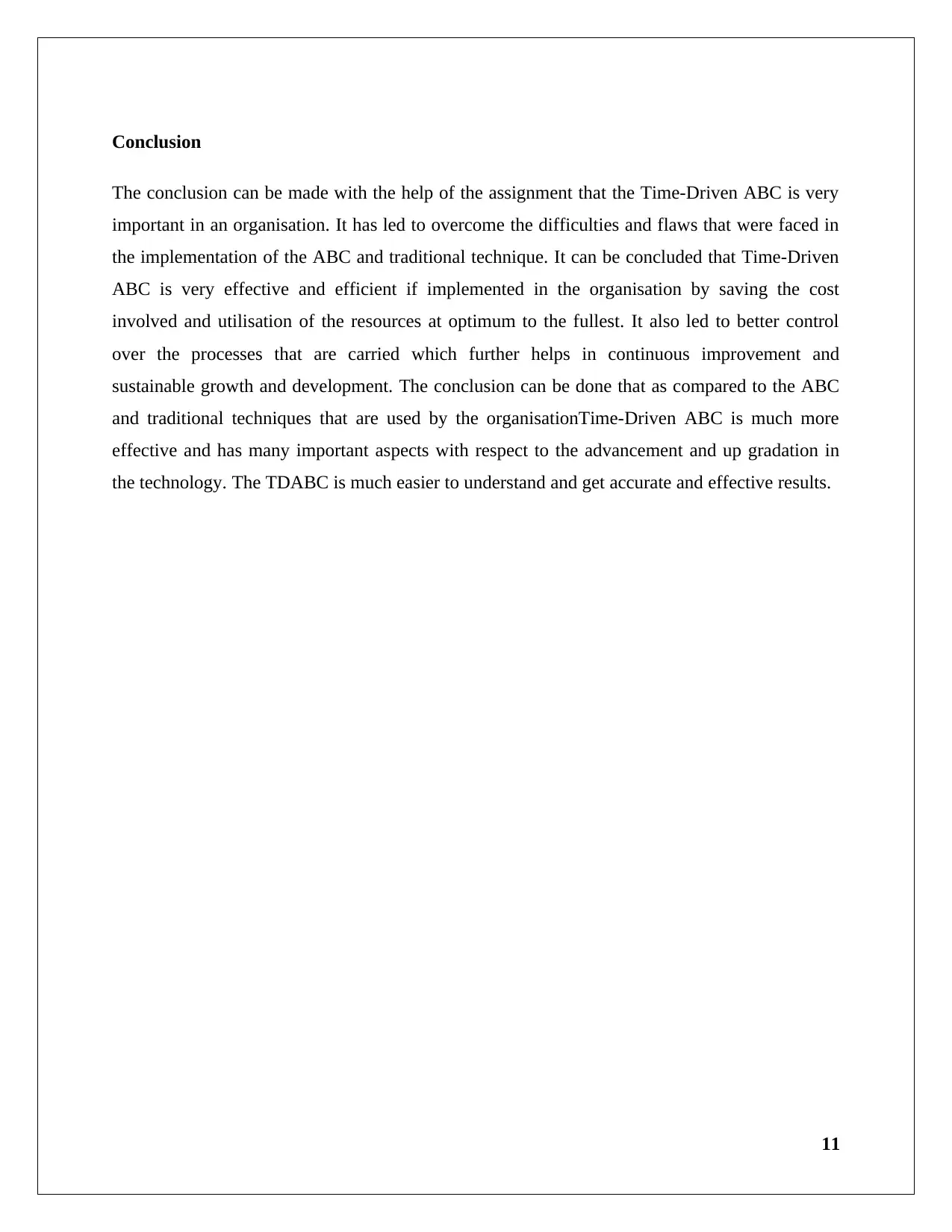
Conclusion
The conclusion can be made with the help of the assignment that the Time-Driven ABC is very
important in an organisation. It has led to overcome the difficulties and flaws that were faced in
the implementation of the ABC and traditional technique. It can be concluded that Time-Driven
ABC is very effective and efficient if implemented in the organisation by saving the cost
involved and utilisation of the resources at optimum to the fullest. It also led to better control
over the processes that are carried which further helps in continuous improvement and
sustainable growth and development. The conclusion can be done that as compared to the ABC
and traditional techniques that are used by the organisationTime-Driven ABC is much more
effective and has many important aspects with respect to the advancement and up gradation in
the technology. The TDABC is much easier to understand and get accurate and effective results.
11
The conclusion can be made with the help of the assignment that the Time-Driven ABC is very
important in an organisation. It has led to overcome the difficulties and flaws that were faced in
the implementation of the ABC and traditional technique. It can be concluded that Time-Driven
ABC is very effective and efficient if implemented in the organisation by saving the cost
involved and utilisation of the resources at optimum to the fullest. It also led to better control
over the processes that are carried which further helps in continuous improvement and
sustainable growth and development. The conclusion can be done that as compared to the ABC
and traditional techniques that are used by the organisationTime-Driven ABC is much more
effective and has many important aspects with respect to the advancement and up gradation in
the technology. The TDABC is much easier to understand and get accurate and effective results.
11
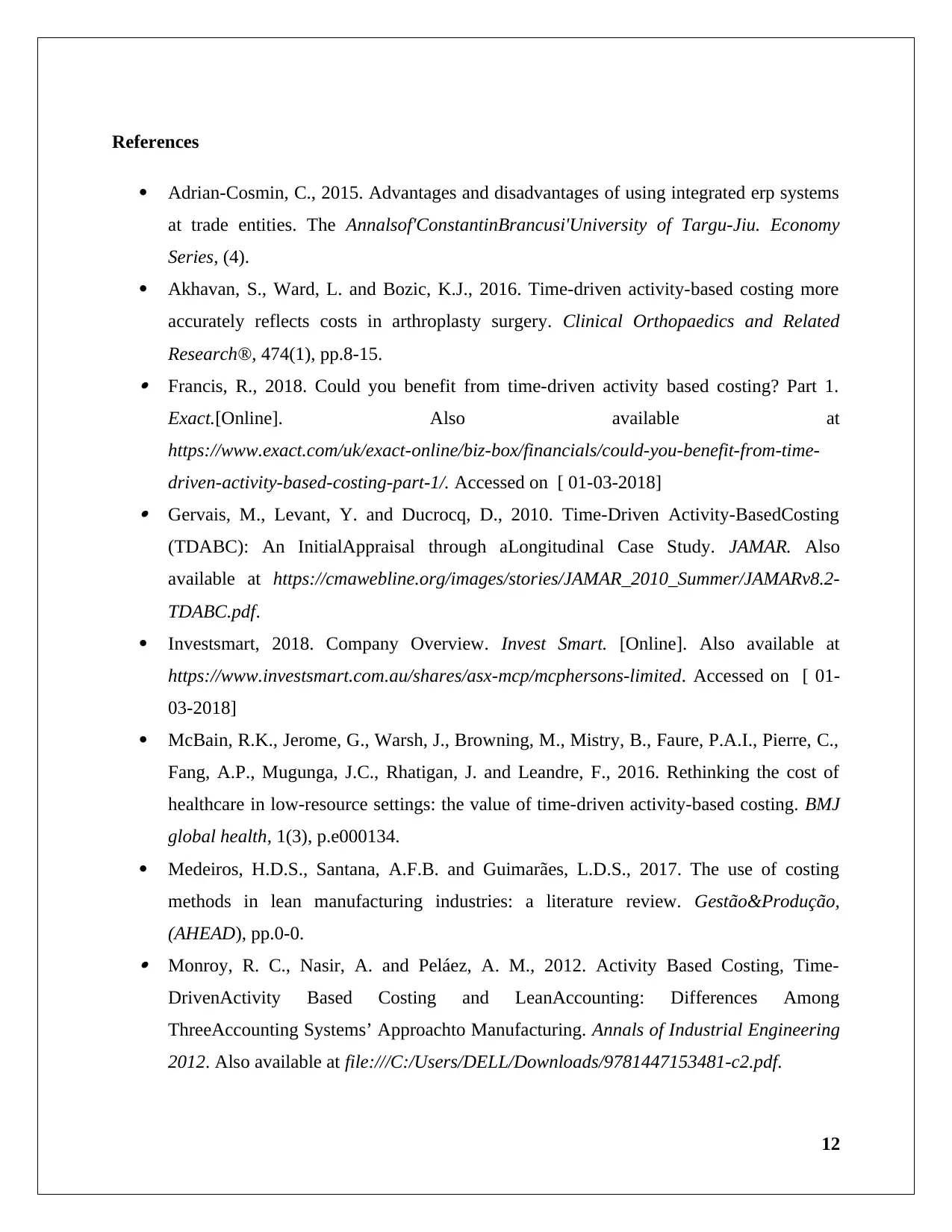
References
Adrian-Cosmin, C., 2015. Advantages and disadvantages of using integrated erp systems
at trade entities. The Annalsof'ConstantinBrancusi'University of Targu-Jiu. Economy
Series, (4).
Akhavan, S., Ward, L. and Bozic, K.J., 2016. Time-driven activity-based costing more
accurately reflects costs in arthroplasty surgery. Clinical Orthopaedics and Related
Research®, 474(1), pp.8-15. Francis, R., 2018. Could you benefit from time-driven activity based costing? Part 1.
Exact.[Online]. Also available at
https://www.exact.com/uk/exact-online/biz-box/financials/could-you-benefit-from-time-
driven-activity-based-costing-part-1/. Accessed on [ 01-03-2018] Gervais, M., Levant, Y. and Ducrocq, D., 2010. Time-Driven Activity-BasedCosting
(TDABC): An InitialAppraisal through aLongitudinal Case Study. JAMAR. Also
available at https://cmawebline.org/images/stories/JAMAR_2010_Summer/JAMARv8.2-
TDABC.pdf.
Investsmart, 2018. Company Overview. Invest Smart. [Online]. Also available at
https://www.investsmart.com.au/shares/asx-mcp/mcphersons-limited. Accessed on [ 01-
03-2018]
McBain, R.K., Jerome, G., Warsh, J., Browning, M., Mistry, B., Faure, P.A.I., Pierre, C.,
Fang, A.P., Mugunga, J.C., Rhatigan, J. and Leandre, F., 2016. Rethinking the cost of
healthcare in low-resource settings: the value of time-driven activity-based costing. BMJ
global health, 1(3), p.e000134.
Medeiros, H.D.S., Santana, A.F.B. and Guimarães, L.D.S., 2017. The use of costing
methods in lean manufacturing industries: a literature review. Gestão&Produção,
(AHEAD), pp.0-0. Monroy, R. C., Nasir, A. and Peláez, A. M., 2012. Activity Based Costing, Time-
DrivenActivity Based Costing and LeanAccounting: Differences Among
ThreeAccounting Systems’ Approachto Manufacturing. Annals of Industrial Engineering
2012. Also available at file:///C:/Users/DELL/Downloads/9781447153481-c2.pdf.
12
Adrian-Cosmin, C., 2015. Advantages and disadvantages of using integrated erp systems
at trade entities. The Annalsof'ConstantinBrancusi'University of Targu-Jiu. Economy
Series, (4).
Akhavan, S., Ward, L. and Bozic, K.J., 2016. Time-driven activity-based costing more
accurately reflects costs in arthroplasty surgery. Clinical Orthopaedics and Related
Research®, 474(1), pp.8-15. Francis, R., 2018. Could you benefit from time-driven activity based costing? Part 1.
Exact.[Online]. Also available at
https://www.exact.com/uk/exact-online/biz-box/financials/could-you-benefit-from-time-
driven-activity-based-costing-part-1/. Accessed on [ 01-03-2018] Gervais, M., Levant, Y. and Ducrocq, D., 2010. Time-Driven Activity-BasedCosting
(TDABC): An InitialAppraisal through aLongitudinal Case Study. JAMAR. Also
available at https://cmawebline.org/images/stories/JAMAR_2010_Summer/JAMARv8.2-
TDABC.pdf.
Investsmart, 2018. Company Overview. Invest Smart. [Online]. Also available at
https://www.investsmart.com.au/shares/asx-mcp/mcphersons-limited. Accessed on [ 01-
03-2018]
McBain, R.K., Jerome, G., Warsh, J., Browning, M., Mistry, B., Faure, P.A.I., Pierre, C.,
Fang, A.P., Mugunga, J.C., Rhatigan, J. and Leandre, F., 2016. Rethinking the cost of
healthcare in low-resource settings: the value of time-driven activity-based costing. BMJ
global health, 1(3), p.e000134.
Medeiros, H.D.S., Santana, A.F.B. and Guimarães, L.D.S., 2017. The use of costing
methods in lean manufacturing industries: a literature review. Gestão&Produção,
(AHEAD), pp.0-0. Monroy, R. C., Nasir, A. and Peláez, A. M., 2012. Activity Based Costing, Time-
DrivenActivity Based Costing and LeanAccounting: Differences Among
ThreeAccounting Systems’ Approachto Manufacturing. Annals of Industrial Engineering
2012. Also available at file:///C:/Users/DELL/Downloads/9781447153481-c2.pdf.
12
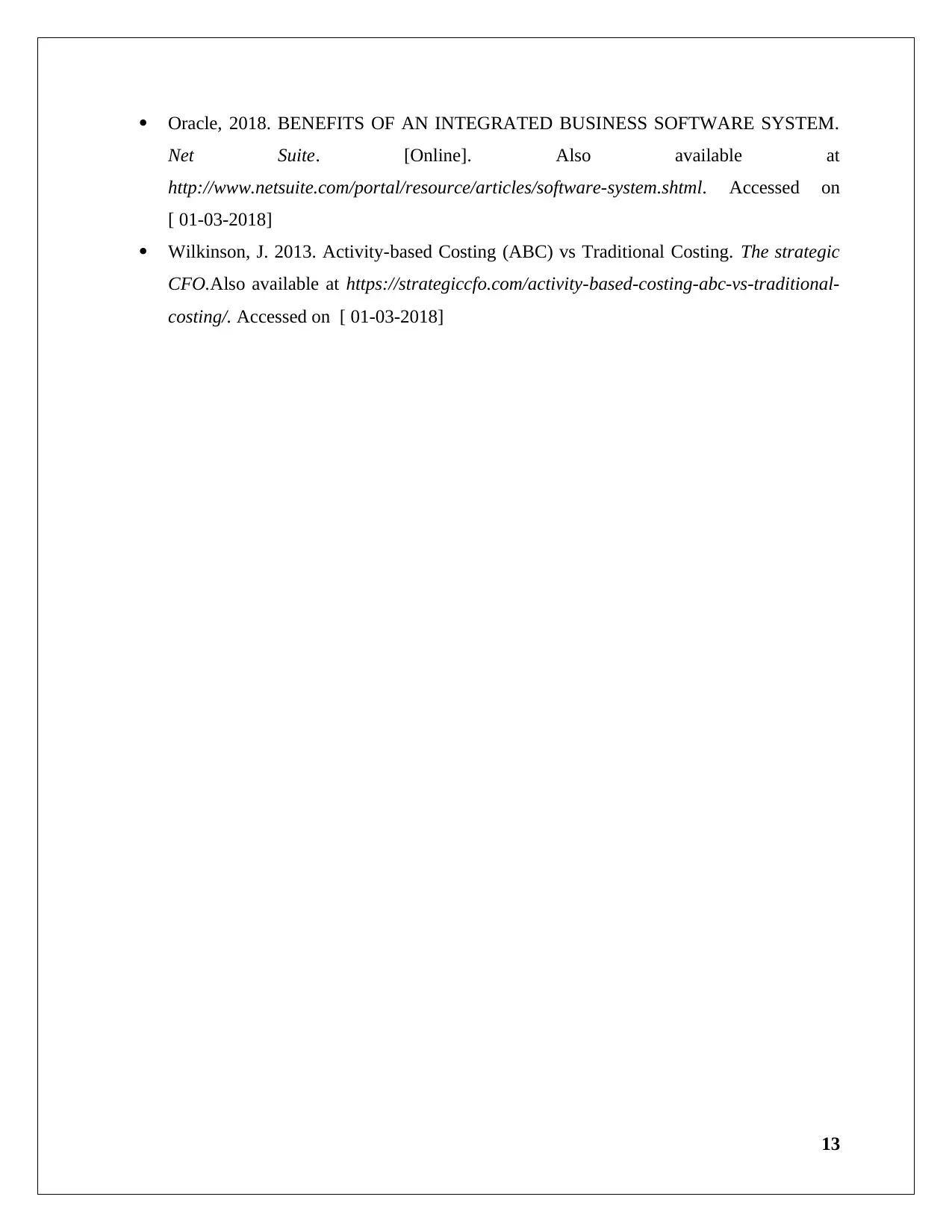
Oracle, 2018. BENEFITS OF AN INTEGRATED BUSINESS SOFTWARE SYSTEM.
Net Suite. [Online]. Also available at
http://www.netsuite.com/portal/resource/articles/software-system.shtml. Accessed on
[ 01-03-2018]
Wilkinson, J. 2013. Activity-based Costing (ABC) vs Traditional Costing. The strategic
CFO.Also available at https://strategiccfo.com/activity-based-costing-abc-vs-traditional-
costing/. Accessed on [ 01-03-2018]
13
Net Suite. [Online]. Also available at
http://www.netsuite.com/portal/resource/articles/software-system.shtml. Accessed on
[ 01-03-2018]
Wilkinson, J. 2013. Activity-based Costing (ABC) vs Traditional Costing. The strategic
CFO.Also available at https://strategiccfo.com/activity-based-costing-abc-vs-traditional-
costing/. Accessed on [ 01-03-2018]
13
1 out of 13
![[object Object]](/_next/static/media/star-bottom.7253800d.svg)





